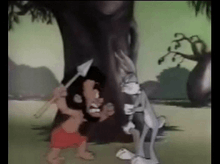Bushy Hare
| Bushy Hare | |
|---|---|
| Looney Tunes (Bugs Bunny) series | |
 Bugs Bunny and Nature Boy | |
| Directed by | Robert McKimson |
| Produced by |
Edward Selzer (uncredited) |
| Story by | Warren Foster |
| Voices by | Mel Blanc |
| Music by | Carl Stalling |
| Animation by |
Phil De Lara J.C. Melendez Charles McKimson Rod Scribner John Carey |
| Layouts by | Cornett Wood |
| Backgrounds by | Richard H. Thomas |
| Distributed by | Warner Bros. Pictures |
| Release date(s) | November 18, 1950 (USA) |
| Color process | Technicolor |
| Running time | 7:15 |
| Language | English |
Bushy Hare is a Looney Tunes Bugs Bunny Cartoon made in 1949, released in 1950, directed by Robert McKimson. Bugs winds up in the Australian Outback, where he is switched with a baby kangaroo and has to deal with an aborigine hunter. The title is a play on "bushy hair" along with aborigines stereotypically being from "the bush" country.
The baby kangaroo is played by Hippety Hopper, in a cameo appearance. This is the only cartoon in which Hippety Hopper is not paired with Sylvester the Cat, and the only one in which the character speaks (with one line at the end); like Bugs, Hippety is voiced by Mel Blanc.
Plot
Bugs pops out in Golden Gate Park and encounters a man, who asks Bugs to hold his balloons while he ties his shoelaces. Bugs complies, but soon finds himself drifting off into the ocean. Eventually he clashes in midair with a stork delivering a kangaroo joey, leading to Bugs getting switched with the joey, brought to Australia, and dropped into a kangaroo's arms. Bugs refuses to be the kangaroo's baby, but feels guilty after the kangaroo starts crying and agrees to be her 'baby'.
After a wild ride inside the kangaroo's pouch, Bugs gets out and is then struck by a boomerang thrown by an aborigine, named Sammy Lawrence. Bugs throws the boomerang away but it hits him again. Sammy confronts Bugs, who teases him into a yelling fit. Sammy throws his spear at Bugs, who runs and dives into a rabbit hole. Bugs tricks Sammy into thinking he's stabbing the rabbit down the hole, then kicks the man down into the hole.
Later Sammy spies Bugs walking and attempts to shoot a poisonous fruit at him, but Bugs blows through his bamboo blowgun, causing the man to ingest the fruit instead. Sammy then chases Bugs in a canoe and then up a cliff where the two of them fight in the kangaroo's pouch in which Sammy gains the upper hand. Finally, Bugs kicks Sammy out and the kangaroo kicks him off of the cliff where he screams in rage and defeat. Then, the joey floats down from the sky into his mother's pouch. The kangaroo gives Bugs a ride back to the US, using an outboard motor to power the kangaroo across the sea.
Edited version and Unofficial ban
- When this cartoon aired on Nickelodeon, a scene wherein Nature Boy has "cornered" Bugs in a hole and starts jabbing his spear into the hole and Bugs meanwhile stands behind him, dramatizing all kinds of death shrieks, was edited; When Bugs finally finishes his death cries with, "Just go away and leave me to die in peace," Nature reacts by laughing with evil delight and jabbing his spear into the hole with more vigor, and Bugs watches with disgust and says, "Why, you little..!" and then kicks Nature into the hole. It is the latter two reactions that were cut so that the cartoon went from, "...leave me to die in peace," directly to where Bugs kicks him into the hole, tickles his feet, and says, "How 'Nature Boy' can you get?!"
- This was one of only 12 Bugs Bunny cartoons skipped from Cartoon Network's 2001 "June Bugs" marathon by order of Time Warner due to Bugs' antagonist being an ethnic stereotype.
Availability
"Bushy Hare" was released on the single-disc Bugs Bunny: Hare Extraordiniare DVD released in August 2010.[1]
References
- ↑ "Archived copy". Archived from the original on 2010-12-02. Retrieved 2010-04-03.
External links
- Bushy Hare on IMDb
| Preceded by Bunker Hill Bunny |
Bugs Bunny Cartoons 1950 |
Succeeded by Rabbit of Seville |